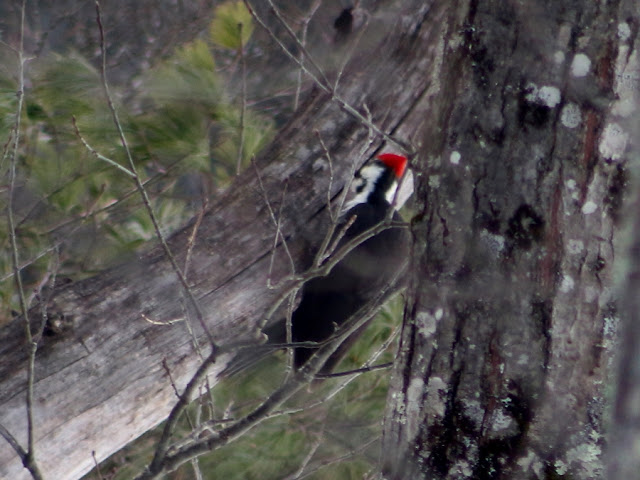The last week of January brought out the woodpeckers, though this red-bellied woodpecker has been frequenting our feeder all winter.
 |
| Red-bellied woodpecker, our most recent addition to the Lakes Region woodpecker family. |
I saw my first red-bellied woodpecker in late 2020 and learned that it has only recently moved this far north from its traditional territory south of Massachusetts (See the December 20, 2020 journal entry for more about this woodpecker) and I'm hearing lots of reports of them being seen all around central New Hampshire now. This bird is larger than our long-resident hairy woodpecker and second in size only to the pileated woodpecker - which also made an appearance this week.
 |
| A female pileated woodpecker, identifed by the black versus red mustache. |
Pileated woodpeckers rarely visit feeders, even suet, unless it's in a large woodpecker-friendly holder; these imposing, active birds feed mostly on insects and are uniquely adapted to extracting them from deep within trees. They have very strong necks and beaks which they use to excavate holes, but the really fascinating aspect is their tongue. The pileated woodpecker's tongue is attached to the end of a long flexible bone that extends from the tip of its beak, continues along the bottom of its head, then wraps up and around the back and top of its head and terminates at its forehead in front of its eyes. Picture a flexible bone shaped like a question mark (?) rotated 90 degrees clockwise. Attached to this bone is a muscle that can push this movable bone far out of its beak to probe into cracks and ant tunnels deep inside a tree. The tongue itself is barbed and sticky so its prey gets stuck to the tongue and pulled back into the birds mouth. [Ref: Sibley, 2020, What it's like to be a Bird, Knopf, pg 91.]
I watched this bird start at the base of a dead branch on an oak tree, exploring every hole, rotten spot, and crack as it made its way to the end of the branch.
A truly remarkable bird.
I noted last week the dearth of soft snow for tracking, but on a trip up Mt. Roberts in the Ossipee Mountains I found plenty of animal tracks at higher elevations where there had been less rain and a bit of fresh snow to reveal the animals' travels. First I saw a very conspicuous statement by a fox claiming its territory.
 |
| Fox use well exposed rocks and logs to leave their calling card for other foxes to see and smell. |
 |
| Lots of mouse tracks at this marking stone. |
I'd think the mice running between that rock and that tree might decide it's not a great neighborhood, but it explains why the fox wants to keep that corner for itself.
Next were lots of deer tracks and many more occurrences of deer hunting for acorns under the snow.
 |
| A large area turned up by deer gleaning acorns. |
Then I came across this strange mark in the snow which I can't figure out.
The tracks beside it look like coyote prints.
And it starts at a disturbed area in the snow.
One guess is a coyote dug something out of the snow and dragged it away. But what? A branch? A long bone? Another less interesting but more likely possibility considering this is right beside the trail is that a domestic dog picked up a stick hoping its owner would throw it!
Higher up on the ledges on the western flank of Mt. Roberts I had a good look at Lake Winnipesaukee, and yes it's all frozen over, even the broads.
 |
| Looking over Winnipesaukee toward the Belknap Range. |
And looking north from the summit of Mt. Roberts, there was Mt. Washington, standing proud, displaying the countenance that gives the White Mountains their name.
 |
| A clear view of Mt. Washington and the Southern Presidentials. |
For those who experienced the brunt of yesterday's Nor'easter I hope everything's ok. We had just a glancing blow here at the Lakes with a few inches of snow, though it was hard to measure due to gusty winds blowing it around.






No comments:
Post a Comment